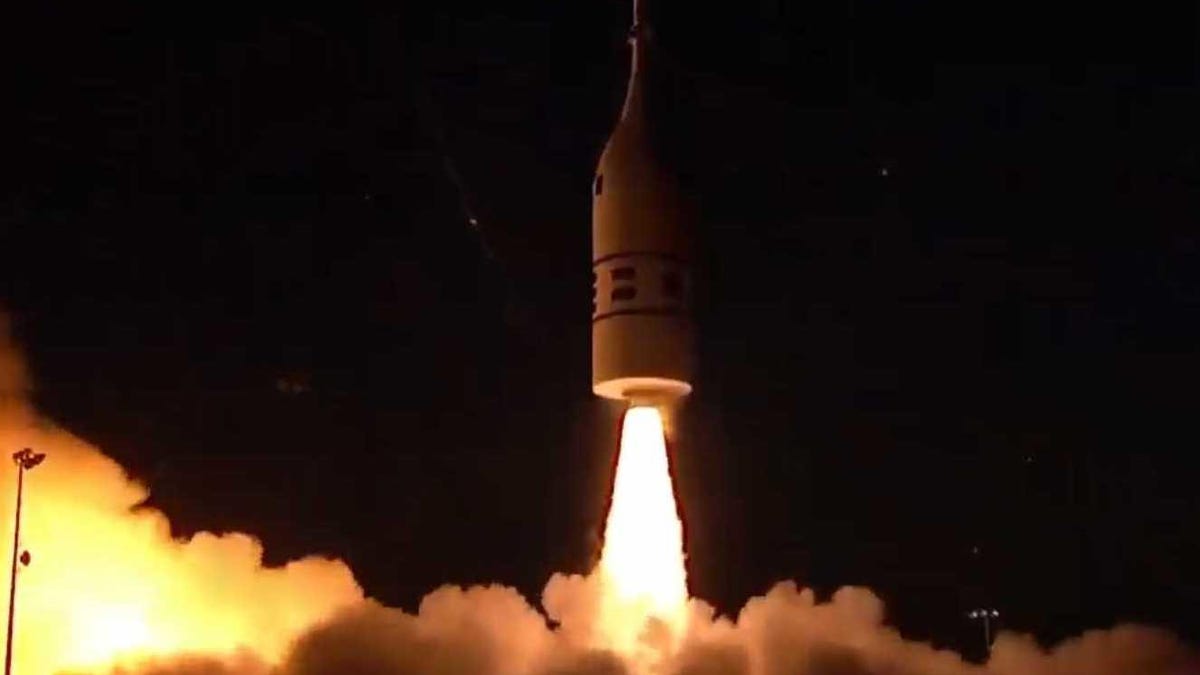NASA Orion aces safety test after 'launching a rocket off a flying rocket'
The Orion spacecraft has completed its final safety test. Next stop is the moon.

NASA's Tuesday launch went smoothly.
NASA has cleared the final hurdle in testing its Orion spacecraft with the completion of the Ascent Abort-2 flight test. The success marks an important milestone for the crew capsule that will put humans back on the moon, demonstrating its safety in an emergency abort scenario.
Launched from Cape Canaveral Air Force Station early Tuesday morning, AA-2 was designed to push the capsule's abort system to its limits with a full-stress test. And while full results of the test are still to be revealed, the capsule was jettisoned from the launch vehicle approximately 55 seconds post-launch, leaving a brilliant trail in the sky. Seconds later, the capsule landed in the ocean with an impressive splash that could be heard more than three miles away.
It was a humid morning in Florida, but Orion, perched on top of a solid-fuel rocket and encased in a fairing assembly, launched right on schedule at 4 a.m. PT. The capsule used for the test operated like a dummy spacecraft, weighted to resemble the real thing, but in effect was just an Orion-shaped box. It was positioned at the bottom of the upside-down golf tee-shaped Launch Abort System.
Test complete! Today’s ~3 minute test of @NASA_Orion spacecraft's launch abort system verified that @NASA_Astronauts can safely get away from their launch vehicle in the case of an emergency after liftoff. More: https://t.co/mUf6z9uYjA pic.twitter.com/nI9CZKT6H9
— NASA (@NASA) July 2, 2019
As it launched, we didn't quite see the dazzling flurry of fire and flame we've become accustomed to with SpaceX launches but, of course, it wasn't meant to be that way. This was a small test lasting only 3 minutes, aimed at ticking off a fundamental crew safeguard of the moon-bound craft.
"Our Launch Abort System is a key safety feature of the spacecraft," said Orion program manager Mark Kirasich prior to the test. "It will protect the crew members who fly on-board Orion during the most challenging part of the mission, which is the ascent phase."
Speaking to CNET in Florida shortly after the launch, Charlie Precourt, a former NASA space shuttle astronaut and head of the propulsion division at Northrop Grumman (the company that built the rocket systems for the abort test), said this was far from a simple test procedure.
"I like to describe it as launching a rocket off of a flying rocket," he said. "It's tough enough to fly a rocket off a still launch pad -- the launch pad for our launch abort system is actually a moving rocket at very high speeds, so it's a very complicated set of computer algorithms that guide the firing of the motor."
Compare that to the abort procedures in place during the shuttle era. On his four shuttle missions from 1993 to 1998, Precourt said, an abort would have required using the remaining thrust to guide the shuttle back into a gliding trajectory, and astronauts would have needed to "jump out the side like paratroopers."
Now with Orion, which NASA is dubbing "the safest spacecraft ever built," a safe abort at launch won't involve jumping out the window.
"It's a dramatic improvement," said Precourt. "It certainly expands the scenarios where we can get the crew back, when in the past we wouldn't have been able to."
The 7 a.m. PT launch was an uncrewed test designed to replicate a real one.
Less than a minute into the flight, the abort sequence was initiated. By that time, the spacecraft had reached Mach 1.3 and hit 31,000 feet in altitude, just a few thousand feet lower than most commercial airliners fly. At that point, the abort motor fired and the crew module blasted away from the launch vehicle, escaping the chasing rocket before falling back to Earth. Once the LAS oriented itself in midflight, it ejected the Orion capsule into the ocean and blasted away. Orion did not contain any parachutes, so it came hurtling back toward the ocean and is set to sleep with the fishes.
NASA has already run a number of high-end computer simulations that aim to stress-test the capsule to see how it fares during an abort. The data collected from the real flight will be analyzed in conjunction with those tests, thanks to a dozen data recorders that were jettisoned every 10 seconds as Orion began free-fall into the sea.
The spacecraft hit 31,000 feet in altitude when the abort sequence was initiated.
Ascent Abort-2 was the last of three tests designed to evaluate the Orion capsule. Although emergency aborts are rather rare in crewed rocket launches, one did occur earlier this year when a Russian Soyuz rocket malfunctioned during ascent. That emergency resulted in a ballistic descent for NASA astronaut Nick Hague and Russian cosmonaut Aleksey Ovchinin. "We have to prepare for this even though its a low likelihood of happening," fellow astronaut Randy Bresnik noted in a prelaunch briefing.
The capsule is slated to fly, for the first time, aboard NASA's next-generation rocket, the Space Launch System, in July 2020. That first flight will be uncrewed and last for approximately 25 days, with the Orion capsule spending around 10 days in orbit around the moon. Success in that mission will pave the way for the Artemis program to ready itself for first human spaceflight missions in 2022.
Originally published July 2, 4:06 a.m. PT.
Update, 5:44 a.m. PT: Adds comment from Northrop Grumman.



